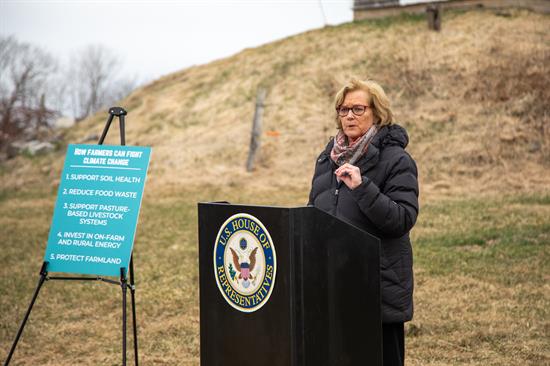Press Releases
How Farmers Are Fighting Climate Change
Washington,
April 18, 2019
How Farmers Are Fighting Climate Change Farming has always been a risky business. These are especially tough times for farmers—they’re operating on thin margins, trade wars are jeopardizing export markets, a serious mental health and substance abuse crisis is ravaging rural communities, and extreme weather events are becoming more frequent. Farmers are acutely feeling the economic effect of climate change, whether it’s the result of changing growing seasons, a 500-year flood, or a prolonged drought. This is making it increasingly difficult for farmers to stay on their land and turn a profit. Inaction on climate change will further threaten the livelihoods of farmers, farmworkers, and rural communities. As we discuss climate change mitigation and adaptation solutions, farmers are our allies. Farmers have a critical role to play in reversing the effects of climate change by improving soil health and increasing the amount of carbon stored in the soil. New technology is helping farmers more easily measure and quantify the outcomes of conservation practices, but there are missing pieces in the infrastructure needed to make that a widespread reality. Any climate solutions must also make economic sense for farmers, so market and policy incentives will be important components. We don’t have to start from scratch. Many farmers are already implementing climate-smart practices on their operations. Additionally, we have a robust network of Natural Resources Conservation Service (NRCS), Farm Service Agency (FSA), and Rural Development offices and field agents across the country. We must use existing U.S. Department of Agriculture (USDA) farm bill programs, infrastructure, and staff. We have innovative research happening at federal labs and land grant universities, as well as Extension agents and non-governmental organizations that can further deploy that research to farmers nationwide. We have ten USDA Climate Hubs across the country that can provide technical assistance to farmers. We also have a track record of successful public-private partnerships in the agriculture space, and we should continue pooling our knowledge and resources. We need to work together. Here are five actions that we can take to acknowledge that farmers are on the frontlines of climate change and are an integral part of any plan to mitigate and adapt to the effects of climate change: Prioritize soil health initiatives o According to the Food and Agriculture Organization of the United Nations, soils store more carbon than the atmosphere and vegetation combined. Healthy soils practices can also boost climate resiliency by improving water quality and quantity, as well as promote farm profitability by increasing productivity. o We need to maintain, expand, and continually improve NRCS working lands programs, including the Environmental Quality Incentives Program and Conservation Stewardship Program, as well as targeted FSA land retirement and conservation buffer initiatives. We need to address any remaining program barriers to adoption of soil health practices, raise soil health as a program priority across the board, and boost outreach and education efforts. We also need to explore new ways to provide voluntary climate mitigation incentives for farmers, such as through tax credits, the establishment of carbon markets for agriculture, or supply chain incentives. It is critical that we help farmers measure and quantify the carbon stored in the soil, as outcomes-verified data and metrics will be key to incentivizing farmers for their soil health investment. USDA can play a significant role by developing common, science-based methodologies. Protect farmland and improve farm viability o According to American Farmland Trust, the U.S. is losing 1.5 million acres of farmland and ranchland a year—or 3 acres every minute. o We need to keep farmers on the land. Taking farmland out of production for development purposes means that we’re not just losing food production capacity, we’re also losing soil carbon sequestration capacity. We need to maintain USDA programs, such as the Agriculture Conservation Easement Program, to protect farmland from development. And in order to keep farmers on their land, we need to ensure that those farms remain viable, creating new economic opportunities and enhanced production over the long-term. Therefore, in addition to the climate mitigation incentives listed above, we need to support farm viability projects, new market development, value-added agricultural enterprises, and growing local, regional, organic, grass-based markets, as well as the research, extension, and outreach initiatives to support those efforts. Support pasture-based livestock systems o Livestock can play an integral role in grazing operations that sequester more carbon than they produce. o Pasture-based livestock systems, especially under management-intensive rotational grazing systems, can help to place and keep more carbon in the soil. We need to prioritize pasture-based livestock systems in agriculture research and marketing programs as part of any climate mitigation and adaptation effort. We also need to continue advancing ways to reduce methane emissions from livestock through improved feed and other innovative means. Additionally, exploring how technologies, such as anaerobic digestion, can be deployed more broadly can help to address manure management. Invest in on-farm and rural energy initiatives o According to USDA’s 2017 Census of Agriculture, the number of farms with renewable energy systems increased 132% from 2012 to 2017. o A recent Island Institute study found that the percentage of household income spent on energy bills is 33% higher in rural areas, despite rural areas producing much of the energy consumed through wind, gas, hydropower, and biomass. Island communities and remote communities face especially high energy costs. o Investing in programs that support energy production on farms and in rural communities, such as USDA’s Rural Energy for America Program, can help to alleviate the financial barriers to rural energy efficiency, thereby reducing the unaffordability of energy. On-farm renewable energy systems create new revenue streams for farmers and can help to diversify their income. Also, as the investment into renewable energy continues to grow, we must ensure that the definition of “renewables” used in programs and tax benefits is inclusive of many sources available in rural America, such as biomass. These sources provide distinct climate benefits in many instances. For example, powering electric vehicles through biomass electricity and other sources can drastically reduce carbon emissions as compared to gasoline. Using agricultural byproducts and waste promotes a circular economy and is a critical part of the supply chain for farms, forests, and rural economies. Inclusive policies will recognize that a wide range of energy can both provide a local and accessible source of energy in rural America. It is essential for USDA, the Environmental Protection Agency (EPA), and the Department of Energy to coordinate as these programs are developed and implemented. Reduce food waste o According to the Food and Agriculture Organization of the United Nations, if food waste were a country, it’d be the third largest greenhouse gas emitting country in the world. o According to EPA, food is the largest component of our daily trash going to landfills. o We need to support food waste reduction efforts throughout the entire supply chain so that food does not end up in a landfill. At the farm level, encouraging and incentivizing the processing and consumption of imperfect product can create new markets for farmers and provide economically-viable opportunities for farmers to harvest food that would otherwise stay in the field. Incentives for composting and anaerobic digestion can also help to divert inedible food from landfills. Food waste prevention requires a dramatic cultural shift, so we also must support robust consumer education to increase awareness nationwide. In 2018, USDA, EPA, and the U.S. Food and Drug Administration signed a formal agreement to work together to reduce food waste and increased federal funding can help to expand that work. |

